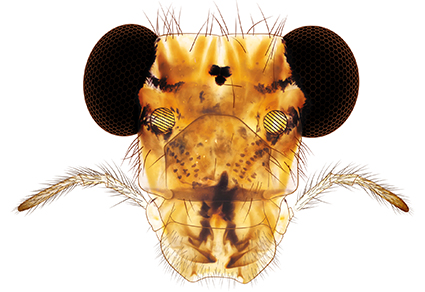Abstract
Based on a survey of species of the genus Triplocania (Psocodea: ‘Psocoptera’) in forests of natural areas of Colombia and Peru, 18 species (14 from Colombia and 4 from Peru) were found, 16 of which are new to science and two correspond to males of Colombian species originally described from females (T. matildae González et al., 2017, and T. sarriae González et al., 2017). The new species, here described and illustrated are: T. altamira n. sp., T. antioquensis n. sp., T. antisuyuensis n. sp., T. atratoensis n. sp., T. caguanensis n. sp., T. caquetensis n. sp., T. einsteini n. sp., T. fabridiazi n. sp., T. galileii n. sp., T. hawkingi n. sp., T. mancocapaci n. sp., T. molanoi n. sp., T. nerudai n. sp., T. roesleri n. sp., T. tahuantisuyuensis n. sp., and T. yupanquii n. sp. The number of species of Triplocania is now raised to 118. To date, the highest number of species are found in Colombia, Brazil and Peru, with 59, 34 and 9 species respectively. An updated identification key to the species of Triplocania (males) is included, as well as a classification of the species in the genus.
References
García Aldrete, A. N. (1999) New species of Triplocania Roesler from Mexico, Central and South America (Insecta, Psocoptera, Ptiloneuridae). Spixiana, 22: 149 – 166.
García Aldrete, A. N. (2000) Two new species of Triplocania Roesler (Psocoptera: Ptiloneuridae). Journal of the Kansas Entomological Society. 73(3): 171–176.
García Aldrete, A.N. (2006) New genera of Psocoptera (Insecta), from Mexico, Belize and Ecuador (Psoquillidae, Ptiloneuridae, Lachesillidae). Zootaxa, 1319: 1–14.
García Aldrete, A.N. (2012) Two new species of Triplocania from Veracruz, Mexico (Psocodea:’Psocoptera’: Ptiloneuridae). Dugesiana, 18(2): 169–173.
García Aldrete, A.N. & Casasola Gonzalez, A. (2012) New species of Triplocania and Lachesilla from Sierra Juárez, Oaxaca, Mexico (Psocodea:’Psocoptera’: Ptiloneuridae, Lachesillidae). Dugesiana, 19(2): 135-141.
González, R., Carrejo, N. & García Aldrete, A.N. (2017) New species of Colombian Triplocania Roesler (Psocodea: ‘Psocoptera’: Ptiloneuridae). Monograph. Zootaxa 4336 (1): 001-113. https://doi.org/10.11646/zootaxa.4336.1.1
Lienhard, C. & Smithers, C.N. (2002) Psocoptera: World Catalogue and Bibliography. Instrumenta Biodiversitatis V. Muséum national d’histoire naturelle. Genéve, Suisse. 745 p.
Moura Lima, D., Silva-Neto, A.M., Bravo, F. & García Aldrete, A.N. (2021) Triplocania Roesler (Psocodea: ‘Psocoptera’: Ptiloneuridae), review of the internal classification, new species, and new records for the state of Bahia, Brazil. Papéis Avulsos de Zoologia, 2021; v. 61: e20216142, 11 p. http://doi.org/10.11606/1807-0205/2021.61.42.
New, T.R. (1972) Some Epipsocetae (Psocoptera) from Central Brazil. Transactions of the Royal Entomological Society of London, 123 (4): 455–497.
New, T.R. (1980) Epipsocetae (Psocoptera) from the Reserva Ducke, Amazonas. Acta Amazonica, 10 (1): 179–206.
Roesler, R. (1940) Neue und wenig bekannte Copeognathengattungen. I. Zoologischer Anzeiger, 129 (9/10): 225–243.
Silva Neto, A.M., Rafael, J.A. & García Aldrete, A.N. (2014) New species of Triplocania Roesler with forewing M3 forked (Psocodea: ’Psocoptera’: Ptiloneuridae), from Brazil. Zootaxa, 3838 (1): 077–086. http://dx.doi.org/10.11646/zootaxa.3838.1.3.
Silva-Neto, A.M., Rafael J.A. & García Aldrete, A.N. (2015) New species of Triplocania Roesler (Psocodea, ’Psocoptera’, Ptiloneuridae), from Brazil and Ecuador. ZooKeys, 505: 103–116. http://dx.doi.org/10.3897/zookeys.505.9870
Silva-Neto, A.M., García Aldrete, A.N. & Rafael J.A. (2016) Twelve new species of Triplocania Roesler (Psocodea: ‘Psocoptera’: Ptiloneuridae), from South America. Zootaxa, 4109 (3): 251–283. http://dx.doi.org/10.11646/zootaxa.4109.3.1
Silva-Neto, A.M., García Aldrete, A.N. & Rafael, J.A. (2018) Triplocania Roesler: a new species, redescriptions, description of the female of Triplocania spinosa Mockford, and revalidation of the original combination of Belicania cervantesi (García Aldrete) (Psocodea: ‘Psocoptera’: Ptiloneuridae). Papéis Avulsos de Zoologia (Online), 58: 1–11. http://doi.org/10.11606/1807-0205/2018.58.21.
Silva-Neto, A.M., Moreira de Castro, M. & Rafael, J.A. (2020) Two new species of Triplocania Roesler (Psocodea: ‘Psocoptera’: Ptiloneuridae), from Ecuador. Dugesiana, 27(2): 159–165.
Silva-Neto, A.M., García Aldrete, A. N., Rafael, J.A. & Lopes Ferreira, R. (2021) Checklist and identification key to Brazilian species of Triplocania Roesler (Psocodea: ‘Psocoptera’: Psocomorpha: Ptiloneuridae), with four new cave-dwelling species. Zootaxa 4938 (5): 537–558. https://doi.org/10.11646/zootaxa.4938.5.2


